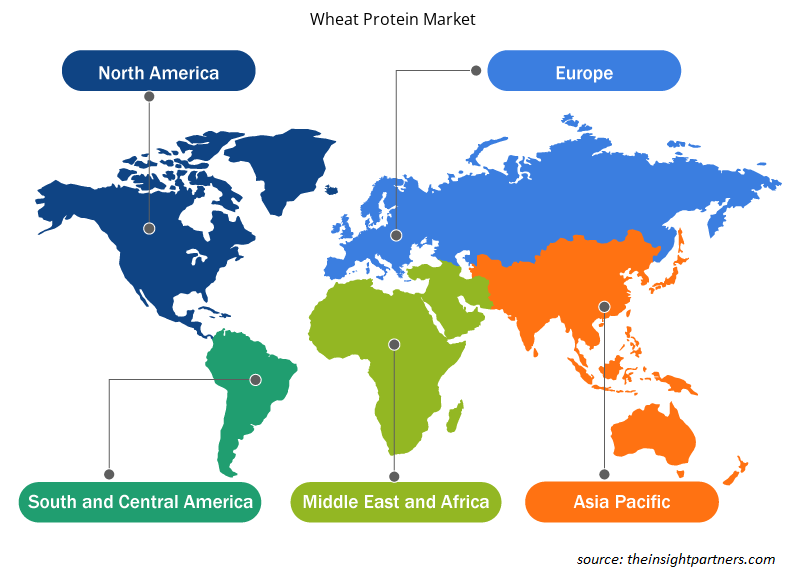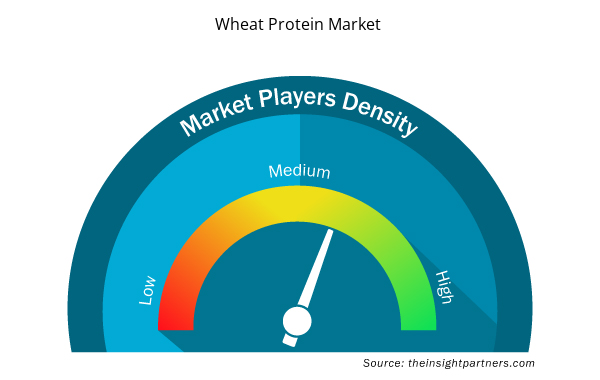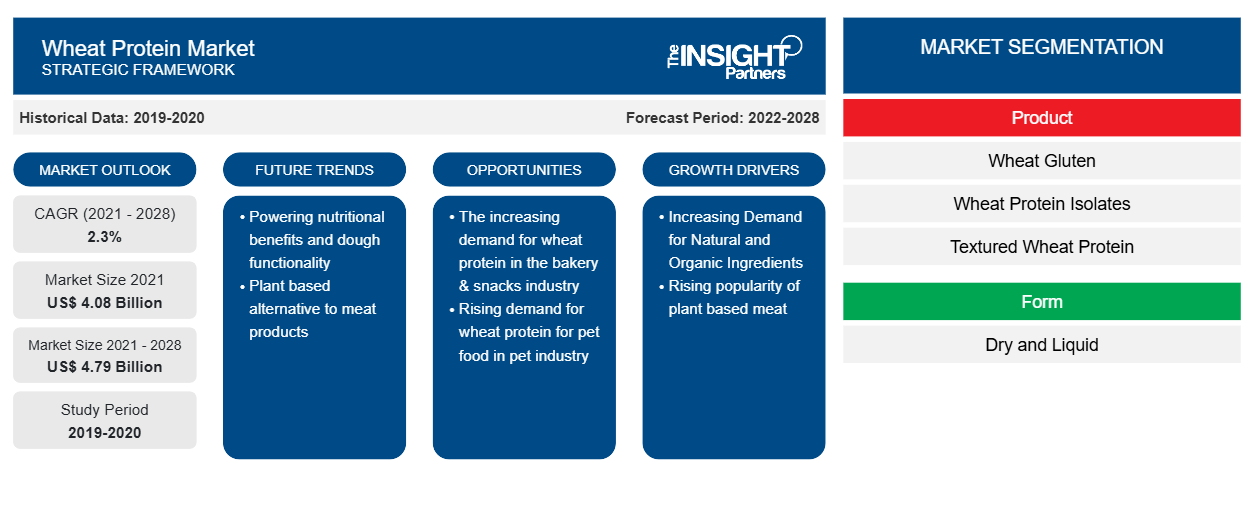[연구보고서] 밀 단백질 시장은 2021년에 4,083.05백만 달러 규모였으며, 2028년까지 4,788.49백만 달러에 도달할 것으로 예상되며, 2021년부터 2028년까지 연평균 성장률 2.3%로 성장할 것으로 예상됩니다.
밀 단백질은 주로 다양한 효소를 사용하여 밀을 가공하여 얻은 식물성 단백질입니다. 이들은 독특한 점탄성 특성을 가지고 있으며 최종 제품에 탄력성과 신장성을 제공하는 불용성 기능성 단백질입니다. 이 단백질은 동물성 단백질에 대한 실행 가능한 대안으로 간주됩니다. 이들은 제과 및 제과 , 화장품 및 개인 관리, 동물 사료 , 영양 보충제와 같은 여러 최종 사용 산업에서 널리 사용됩니다.
2020년 유럽은 글로벌 밀 단백질 시장 에서 가장 큰 매출 점유율을 차지했습니다 . 유럽 시장은 독일, 프랑스, 이탈리아, 영국, 러시아 및 유럽의 나머지 지역으로 세분화됩니다. 소비자의 건강 인식이 높아짐에 따라 대두, 밀, 귀리 와 같은 수많은 식물성 단백질 제품에 대한 수요가 촉진됩니다 . 밀 단백질의 인기는 특히 독일, 프랑스, 영국에서 이 지역 전체에서 증가했습니다. 유럽인들은 점점 더 플렉시테리언 식단을 채택하고 있습니다. 즉, 육류 소비의 일부 또는 대부분을 대체 단백질 식품으로 대체합니다. 이러한 요인들이 유럽에서 밀 단백질 제품에 대한 수요를 촉진합니다.
귀하의 요구 사항에 맞게 이 보고서를 사용자 정의하세요
이 보고서의 일부 또는 국가 수준 분석, Excel 데이터 팩을 포함하여 모든 보고서에 대한 사용자 정의를 무료로 받을 수 있으며 신생 기업 및 대학을 위한 훌륭한 혜택과 할인 혜택을 이용할 수 있습니다.
- 이 보고서의 주요 시장 동향을 알아보세요.이 무료 샘플에는 시장 동향부터 추정 및 예측까지 다양한 데이터 분석이 포함됩니다.
식품 및 음료 산업과 같은 많은 산업이 COVID-19 팬데믹으로 인해 전례 없는 어려움에 직면했습니다. 원자재 공급 부족, 공장 폐쇄, 노동력 부족 및 COVID-19 안전 프로토콜에 따른 운영의 다른 어려움으로 인해 밀 단백질 제조에 관련된 회사는 팬데믹 초기 몇 달 동안 어려움에 직면했습니다. 식품 및 음료 부문은 밀 단백질의 대량 소비자이며 진행 중인 COVID-19 팬데믹은 밀 단백질 수요에 부정적인 영향을 미쳤습니다. 베이커리 제품, 과자류, 유제품과 같은 식품 및 음료 제품은 슈퍼마켓이 발병으로 인해 주식 우선순위를 필수품과 필수품으로 재할당함에 따라 밀려나고 있습니다. 그러나 경제가 운영을 회복함에 따라 앞으로 몇 달 동안 전 세계적으로 밀 단백질 수요가 급증할 것으로 예상됩니다. COVID-19 팬데믹으로 인해 건강하고 기능성 베이커리 제품에 대한 수요가 증가하여 향후 몇 년 동안 밀 단백질 시장 성장을 촉진할 것으로 예상됩니다.
시장 통찰력
천연 및 유기 성분에 대한 수요 증가
유기농 식품의 중요성은 건강 문제가 심각해지면서 알려졌고, 유기농 인증에 대한 의식이 높아지고 고품질 식품에 대한 선호도가 높아지고 있습니다. 요즘 소비자들은 적절한 라벨이 붙은 자연스럽고 깨끗하며 간단한 재료를 찾고 있는데, 이는 제품의 내용, 품질, 사용 의도를 효과적으로 전달할 수 있습니다. 게다가 그들은 유기농 및 천연 식품에 크게 의존하고 있습니다. 예를 들어, 유기농 밀 단백질의 소비는 식품 및 음료, 동물 및 수산 사료와 같은 다양한 응용 분야에서 광범위하게 증가하고 있습니다. 따라서 밀 단백질 제조업체는 유기농 밀 단백질을 개발하고 마케팅하는 데 주력하고 있습니다.
제품 통찰력
제품 기준으로 글로벌 밀 단백질 시장은 밀 글루텐, 밀 단백질 분리물, 조직화된 밀 단백질, 가수분해된 밀 단백질로 세분화됩니다. 2020년에 밀 글루텐 세그먼트가 가장 큰 매출 점유율을 차지했습니다. Vital 밀 글루텐은 베이킹에 첨가제로 사용됩니다. 통밀가루나 호밀가루와 같이 글루텐이 낮은 밀가루에 탄력성을 더합니다. 밀 글루텐은 또한 생 반죽의 부풀기를 개선하고 최종 제품의 질감과 씹힘성을 향상시킵니다.
양식 통찰력
밀 단백질 시장은 형태에 따라 건조 및 액상으로 나뉩니다. 2020년에는 건조 세그먼트가 더 큰 매출 점유율을 차지했습니다. 건조 밀 단백질의 몇 가지 특성은 모든 pH 값에서 물에 대한 높은 용해성, 물 결합 및 유화, 낮은 점도, 산성 및 열 안정성입니다. 건조 밀 단백질은 제빵점, 반려동물 사료, 영양 바, 가공육 및 육류 유사 식품에서 점점 더 많이 사용되고 있습니다. 따라서 식품 산업의 광범위한 응용 분야는 건조 세그먼트의 시장 성장을 뒷받침하고 있습니다.
애플리케이션 인사이트
밀 단백질 시장은 응용 분야별로 베이커리 및 간식, 반려동물 사료, 영양 바 및 음료, 가공육, 육류 유사 제품 등으로 세분화됩니다. 2020년에는 베이커리 및 간식 부문이 가장 큰 매출 점유율을 차지했습니다. 롤, 빵, 쿠키, 페이스트리, 파이, 머핀과 같은 수많은 베이커리 제품이 소비자들에게 인기가 있습니다. 밀 단백질은 반죽의 거동을 최적화하고 최종 제품의 영양적 특성을 향상시키는 일반적인 성분 중 하나입니다. 베이커리 및 간식 산업에서 밀 단백질에 대한 수요가 증가하고 클린 라벨 추세가 전 세계 밀 단백질 시장에서 활동하는 업체에게 충분한 기회를 창출하고 있습니다.
Archer Daniels Midland Company; Roquette Frères; Glico Nutrition Co., Ltd; Kröner-Stärke GmbH; Cargill, Incorporated; Crespel & Deiters GmbH & Co. KG; CropEnergies AG; Manildra Group; MGP Ingredients Inc.; 및 Tereos Group은 글로벌 밀 단백질 시장에서 몇몇 확고한 입지를 굳힌 업체입니다. 이 시장의 회사들은 제품 개발, 공장 확장, 합병 및 인수와 같은 다양한 전략을 채택하여 전 세계적으로 입지를 확장하고 최종 사용자의 증가하는 수요를 충족하고 있습니다. 예를 들어, 2020년에 Archer Daniels Midland Company는 신제품을 개발했습니다. 이 제품에는 Arcon T 텍스처 완두콩 단백질, Prolite MeatTEX 텍스처 밀 단백질, Prolite MeatXT 비텍스처 밀 단백질이 포함되어 있습니다.
스포트라이트 보고서
- 글로벌 밀 단백질 시장의 진보적인 산업 동향은 플레이어가 효과적인 장기 전략을 개발하는 데 도움이 됩니다.
- 선진국과 개발도상국 시장에서 채택한 사업 성장 전략
- 2019년부터 2028년까지 글로벌 밀 단백질 시장의 정량적 분석
- 다양한 산업에 걸친 밀 단백질 수요 추산
- 경쟁 시장 상황과 밀 단백질 수요를 이해하기 위한 최근 동향
- 밀 단백질 시장 성장을 주도하고 제한하는 요인과 함께 시장 동향 및 전망
- 글로벌 밀 단백질 시장 성장과 관련하여 상업적 이익을 뒷받침하는 전략을 이해하여 의사 결정 프로세스
- 시장의 다양한 노드에서의 밀 단백질 시장 규모
- 글로벌 밀 단백질 시장의 자세한 개요 및 세분화와 산업 내 역학
- 유망한 성장 기회가 있는 다양한 지역의 밀 단백질 시장 규모
밀 단백질 시장 지역 통찰력
Insight Partners의 분석가들은 예측 기간 동안 밀 단백질 시장에 영향을 미치는 지역적 추세와 요인을 철저히 설명했습니다. 이 섹션에서는 북미, 유럽, 아시아 태평양, 중동 및 아프리카, 남미 및 중미의 밀 단백질 시장 세그먼트와 지리에 대해서도 설명합니다.

- 밀 단백질 시장에 대한 지역별 데이터 얻기
밀 단백질 시장 보고서 범위
| 보고서 속성 | 세부 |
|---|---|
| 2021년 시장 규모 | 40억 8천만 달러 |
| 2028년까지 시장 규모 | 47억 9천만 달러 |
| 글로벌 CAGR (2021-2028) | 2.3% |
| 역사적 데이터 | 2019-2020 |
| 예측 기간 | 2022-2028 |
| 다루는 세그먼트 | 제품별로
|
| 포함된 지역 및 국가 | 북아메리카
|
| 시장 선도 기업 및 주요 회사 프로필 |
|
밀 단백질 시장 플레이어 밀도: 비즈니스 역학에 미치는 영향 이해
밀 단백질 시장 시장은 소비자 선호도의 변화, 기술 발전, 제품의 이점에 대한 인식 증가와 같은 요인으로 인해 최종 사용자 수요가 증가함에 따라 빠르게 성장하고 있습니다. 수요가 증가함에 따라 기업은 제품을 확장하고, 소비자의 요구를 충족하기 위해 혁신하고, 새로운 트렌드를 활용하여 시장 성장을 더욱 촉진하고 있습니다.
시장 참여자 밀도는 특정 시장이나 산업 내에서 운영되는 회사나 기업의 분포를 말합니다. 주어진 시장 공간에 얼마나 많은 경쟁자(시장 참여자)가 존재하는지 그 규모나 총 시장 가치에 비해 나타냅니다.
밀 단백질 시장에서 활동하는 주요 회사는 다음과 같습니다.
- 아처 대니얼스 미들랜드 컴퍼니
- 로케트 프레르
- 글리코 영양 주식회사
- 크로너-슈테르케 GmbH
- 카길 주식회사
면책 조항 : 위에 나열된 회사는 어떤 특별한 순서에 따라 순위가 매겨지지 않았습니다.

- 밀 단백질 시장의 주요 기업 개요를 알아보세요
밀 단백질 시장,
- 제품
- 밀 글루텐
- 밀 단백질 분리물
- 조직화된 밀 단백질
- 가수분해 밀 단백질
밀 단백질 시장, 형태별
- 마른
- 액체
밀 단백질 시장, 응용 분야별
- 베이커리 & 스낵
- 애완동물 사료
- 영양바 & 음료
- 가공육
- 고기 유사품
- 기타
회사 프로필
- 아처 대니얼스 미들랜드 컴퍼니
- 로케트 프레르
- 글리코 영양 주식회사
- 크로너-슈테르케 GmbH
- 카길 주식회사
- Crespel & Deiters GmbH & Co. KG
- 크롭에너지 AG
- 마닐라드라 그룹
- MGP 인그리디언츠 주식회사
- 테레오스 그룹
- 역사적 분석(2년), 기준 연도, CAGR을 포함한 예측(7년)
- PEST 및 SWOT 분석
- 시장 규모 가치/양 - 글로벌, 지역, 국가
- 산업 및 경쟁 환경
- Excel 데이터 세트


- Bathroom Vanities Market
- Medical Second Opinion Market
- Legal Case Management Software Market
- UV Curing System Market
- Environmental Consulting Service Market
- Electronic Signature Software Market
- Toothpaste Market
- Personality Assessment Solution Market
- Sodium Bicarbonate Market
- Collagen Peptides Market

Report Coverage
Revenue forecast, Company Analysis, Industry landscape, Growth factors, and Trends

Segment Covered
This text is related
to segments covered.

Regional Scope
North America, Europe, Asia Pacific, Middle East & Africa, South & Central America

Country Scope
This text is related
to country scope.
자주 묻는 질문
Rising application of wheat protein in several end-user industries is one of the key factors for the growth of the global wheat protein market. The change in consumer preference toward ready-to-eat foodstuffs has augmented the demand for bakery products, thereby influencing the growth of the wheat protein market. Further, increasing demand for premium pet food products from developing and developed countries, growing demand for natural and organic ingredients, and rising demand for meat analogs are the other factors driving the wheat protein market.
During the forecast period, Europe is anticipated to account for the largest share of the global wheat protein market. With rising health awareness among consumers, the demand for plant protein products, including soy, wheat, oat, and others, is expected to continue growing during the projected period. The popularity of the wheat protein has increased within the region, particularly in Germany, France, and the UK. Europeans are increasingly adopting the flexitarian diet, i.e., replacing part or most of their meat consumption with alternative protein food. Also, government support is driving the growth of this market.
The major players operating in the global wheat protein market are Archer Daniels Midland Company; Roquette Frères; Glico Nutrition Co.,Ltd; Kröner-Stärke GmbH; Cargill, Incorporated; Crespel & Deiters GmbH & Co. KG; Croproteinses AG; Manildra Group; MGP Ingredients Inc.; and Tereos Group
On the basis of product, the textured wheat protein segment led the global wheat protein market in 2020. Textured wheat protein products have broader applications, as a protein enrichment in baked goods, as a meat extension in meat products, for goulash, pulled products, for toppings, for a firm bite in burgers and fillings, as a meat extension in nuggets, and meat emulsions & raw sausages. Due to the wider application of textured wheat protein products, the market for wheat protein is blooming at a rapid pace.
Based on application, bakery & snacks segment accounted for the largest share in the global wheat protein market in 2020. The growth is attributed to rapidly evolving consumer preferences, greater demand for indulgence foods, increasing health consciousness among consumers. Wheat protein is a crucial source of high-protein, low-carb, and high-fibre, essential for producing bakery & snack products.
Based on form, the dry segment accounted for the largest share in the global wheat protein market. Dry wheat proteins are made from vital wheat gluten and are soluble in water. The dry wheat protein is increasingly used in bakeries, pet food, nutritional bars, processed meat, and meat analogs. Thus, the wide applications in the food industry are bolstering the dry segment growth.
Trends and growth analysis reports related to Food and Beverages : READ MORE..
The List of Companies - Wheat Protein Market
- Archer Daniels Midland Company
- Roquette Frères
- Glico Nutrition Co.,Ltd
- Kröner-Stärke GmbH
- Cargill, Incorporated
- Crespel & Deiters GmbH & Co. KG
- CropEnergies AG
- Manildra Group
- MGP Ingredients Inc.
- Tereos Group
The Insight Partners performs research in 4 major stages: Data Collection & Secondary Research, Primary Research, Data Analysis and Data Triangulation & Final Review.
- Data Collection and Secondary Research:
As a market research and consulting firm operating from a decade, we have published and advised several client across the globe. First step for any study will start with an assessment of currently available data and insights from existing reports. Further, historical and current market information is collected from Investor Presentations, Annual Reports, SEC Filings, etc., and other information related to company’s performance and market positioning are gathered from Paid Databases (Factiva, Hoovers, and Reuters) and various other publications available in public domain.
Several associations trade associates, technical forums, institutes, societies and organization are accessed to gain technical as well as market related insights through their publications such as research papers, blogs and press releases related to the studies are referred to get cues about the market. Further, white papers, journals, magazines, and other news articles published in last 3 years are scrutinized and analyzed to understand the current market trends.
- Primary Research:
The primarily interview analysis comprise of data obtained from industry participants interview and answers to survey questions gathered by in-house primary team.
For primary research, interviews are conducted with industry experts/CEOs/Marketing Managers/VPs/Subject Matter Experts from both demand and supply side to get a 360-degree view of the market. The primary team conducts several interviews based on the complexity of the markets to understand the various market trends and dynamics which makes research more credible and precise.
A typical research interview fulfils the following functions:
- Provides first-hand information on the market size, market trends, growth trends, competitive landscape, and outlook
- Validates and strengthens in-house secondary research findings
- Develops the analysis team’s expertise and market understanding
Primary research involves email interactions and telephone interviews for each market, category, segment, and sub-segment across geographies. The participants who typically take part in such a process include, but are not limited to:
- Industry participants: VPs, business development managers, market intelligence managers and national sales managers
- Outside experts: Valuation experts, research analysts and key opinion leaders specializing in the electronics and semiconductor industry.
Below is the breakup of our primary respondents by company, designation, and region:

Once we receive the confirmation from primary research sources or primary respondents, we finalize the base year market estimation and forecast the data as per the macroeconomic and microeconomic factors assessed during data collection.
- Data Analysis:
Once data is validated through both secondary as well as primary respondents, we finalize the market estimations by hypothesis formulation and factor analysis at regional and country level.
- Macro-Economic Factor Analysis:
We analyse macroeconomic indicators such the gross domestic product (GDP), increase in the demand for goods and services across industries, technological advancement, regional economic growth, governmental policies, the influence of COVID-19, PEST analysis, and other aspects. This analysis aids in setting benchmarks for various nations/regions and approximating market splits. Additionally, the general trend of the aforementioned components aid in determining the market's development possibilities.
- Country Level Data:
Various factors that are especially aligned to the country are taken into account to determine the market size for a certain area and country, including the presence of vendors, such as headquarters and offices, the country's GDP, demand patterns, and industry growth. To comprehend the market dynamics for the nation, a number of growth variables, inhibitors, application areas, and current market trends are researched. The aforementioned elements aid in determining the country's overall market's growth potential.
- Company Profile:
The “Table of Contents” is formulated by listing and analyzing more than 25 - 30 companies operating in the market ecosystem across geographies. However, we profile only 10 companies as a standard practice in our syndicate reports. These 10 companies comprise leading, emerging, and regional players. Nonetheless, our analysis is not restricted to the 10 listed companies, we also analyze other companies present in the market to develop a holistic view and understand the prevailing trends. The “Company Profiles” section in the report covers key facts, business description, products & services, financial information, SWOT analysis, and key developments. The financial information presented is extracted from the annual reports and official documents of the publicly listed companies. Upon collecting the information for the sections of respective companies, we verify them via various primary sources and then compile the data in respective company profiles. The company level information helps us in deriving the base number as well as in forecasting the market size.
- Developing Base Number:
Aggregation of sales statistics (2020-2022) and macro-economic factor, and other secondary and primary research insights are utilized to arrive at base number and related market shares for 2022. The data gaps are identified in this step and relevant market data is analyzed, collected from paid primary interviews or databases. On finalizing the base year market size, forecasts are developed on the basis of macro-economic, industry and market growth factors and company level analysis.
- Data Triangulation and Final Review:
The market findings and base year market size calculations are validated from supply as well as demand side. Demand side validations are based on macro-economic factor analysis and benchmarks for respective regions and countries. In case of supply side validations, revenues of major companies are estimated (in case not available) based on industry benchmark, approximate number of employees, product portfolio, and primary interviews revenues are gathered. Further revenue from target product/service segment is assessed to avoid overshooting of market statistics. In case of heavy deviations between supply and demand side values, all thes steps are repeated to achieve synchronization.
We follow an iterative model, wherein we share our research findings with Subject Matter Experts (SME’s) and Key Opinion Leaders (KOLs) until consensus view of the market is not formulated – this model negates any drastic deviation in the opinions of experts. Only validated and universally acceptable research findings are quoted in our reports.
We have important check points that we use to validate our research findings – which we call – data triangulation, where we validate the information, we generate from secondary sources with primary interviews and then we re-validate with our internal data bases and Subject matter experts. This comprehensive model enables us to deliver high quality, reliable data in shortest possible time.


 이 보고서에 대한 무료 샘플을 받으세요
이 보고서에 대한 무료 샘플을 받으세요